Qiang Duan
Enhancing Vehicular Platooning with Wireless Federated Learning: A Resource-Aware Control Framework
Jul 01, 2025Abstract:This paper aims to enhance the performance of Vehicular Platooning (VP) systems integrated with Wireless Federated Learning (WFL). In highly dynamic environments, vehicular platoons experience frequent communication changes and resource constraints, which significantly affect information exchange and learning model synchronization. To address these challenges, we first formulate WFL in VP as a joint optimization problem that simultaneously considers Age of Information (AoI) and Federated Learning Model Drift (FLMD) to ensure timely and accurate control. Through theoretical analysis, we examine the impact of FLMD on convergence performance and develop a two-stage Resource-Aware Control framework (RACE). The first stage employs a Lagrangian dual decomposition method for resource configuration, while the second stage implements a multi-agent deep reinforcement learning approach for vehicle selection. The approach integrates Multi-Head Self-Attention and Long Short-Term Memory networks to capture spatiotemporal correlations in communication states. Experimental results demonstrate that, compared to baseline methods, the proposed framework improves AoI optimization by up to 45%, accelerates learning convergence, and adapts more effectively to dynamic VP environments on the AI4MARS dataset.
Out-of-Distribution Generalization in Time Series: A Survey
Mar 18, 2025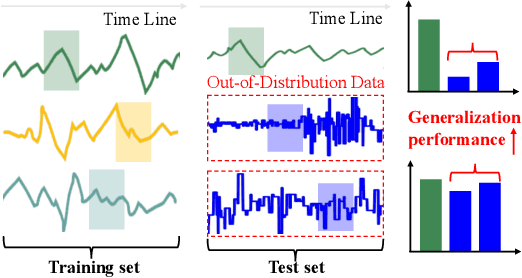
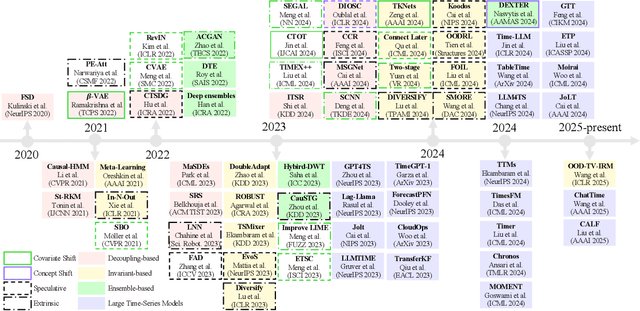
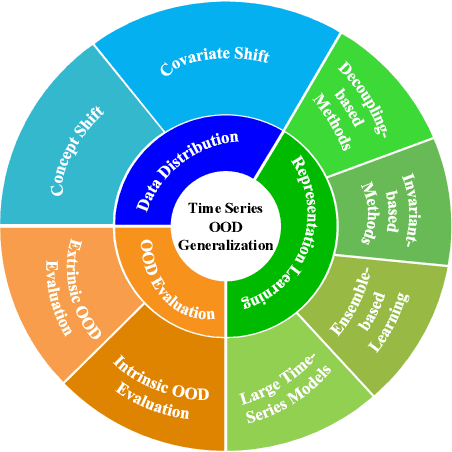
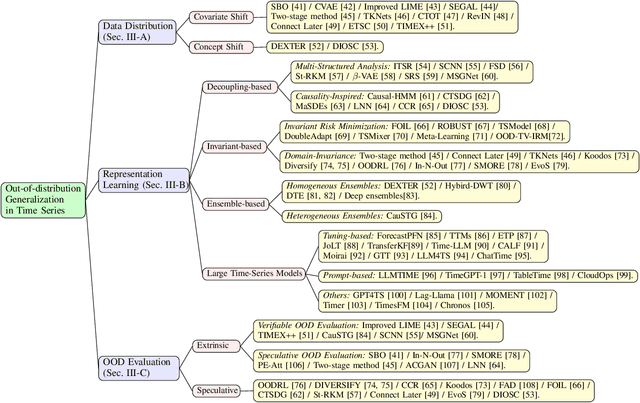
Abstract:Time series frequently manifest distribution shifts, diverse latent features, and non-stationary learning dynamics, particularly in open and evolving environments. These characteristics pose significant challenges for out-of-distribution (OOD) generalization. While substantial progress has been made, a systematic synthesis of advancements remains lacking. To address this gap, we present the first comprehensive review of OOD generalization methodologies for time series, organized to delineate the field's evolutionary trajectory and contemporary research landscape. We organize our analysis across three foundational dimensions: data distribution, representation learning, and OOD evaluation. For each dimension, we present several popular algorithms in detail. Furthermore, we highlight key application scenarios, emphasizing their real-world impact. Finally, we identify persistent challenges and propose future research directions. A detailed summary of the methods reviewed for the generalization of OOD in time series can be accessed at https://tsood-generalization.com.
Backdoor Attack on Vertical Federated Graph Neural Network Learning
Oct 15, 2024Abstract:Federated Graph Neural Network (FedGNN) is a privacy-preserving machine learning technology that combines federated learning (FL) and graph neural networks (GNNs). It offers a privacy-preserving solution for training GNNs using isolated graph data. Vertical Federated Graph Neural Network (VFGNN) is an important branch of FedGNN, where data features and labels are distributed among participants, and each participant has the same sample space. Due to the difficulty of accessing and modifying distributed data and labels, the vulnerability of VFGNN to backdoor attacks remains largely unexplored. In this context, we propose BVG, the first method for backdoor attacks in VFGNN. Without accessing or modifying labels, BVG uses multi-hop triggers and requires only four target class nodes for an effective backdoor attack. Experiments show that BVG achieves high attack success rates (ASR) across three datasets and three different GNN models, with minimal impact on main task accuracy (MTA). We also evaluate several defense methods, further validating the robustness and effectiveness of BVG. This finding also highlights the need for advanced defense mechanisms to counter sophisticated backdoor attacks in practical VFGNN applications.
UIFV: Data Reconstruction Attack in Vertical Federated Learning
Jun 18, 2024



Abstract:Vertical Federated Learning (VFL) facilitates collaborative machine learning without the need for participants to share raw private data. However, recent studies have revealed privacy risks where adversaries might reconstruct sensitive features through data leakage during the learning process. Although data reconstruction methods based on gradient or model information are somewhat effective, they reveal limitations in VFL application scenarios. This is because these traditional methods heavily rely on specific model structures and/or have strict limitations on application scenarios. To address this, our study introduces the Unified InverNet Framework into VFL, which yields a novel and flexible approach (dubbed UIFV) that leverages intermediate feature data to reconstruct original data, instead of relying on gradients or model details. The intermediate feature data is the feature exchanged by different participants during the inference phase of VFL. Experiments on four datasets demonstrate that our methods significantly outperform state-of-the-art techniques in attack precision. Our work exposes severe privacy vulnerabilities within VFL systems that pose real threats to practical VFL applications and thus confirms the necessity of further enhancing privacy protection in the VFL architecture.
LAECIPS: Large Vision Model Assisted Adaptive Edge-Cloud Collaboration for IoT-based Perception System
Apr 16, 2024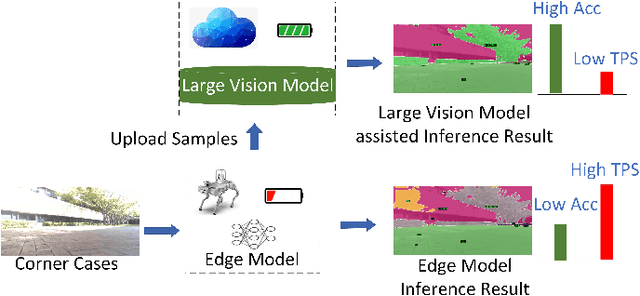
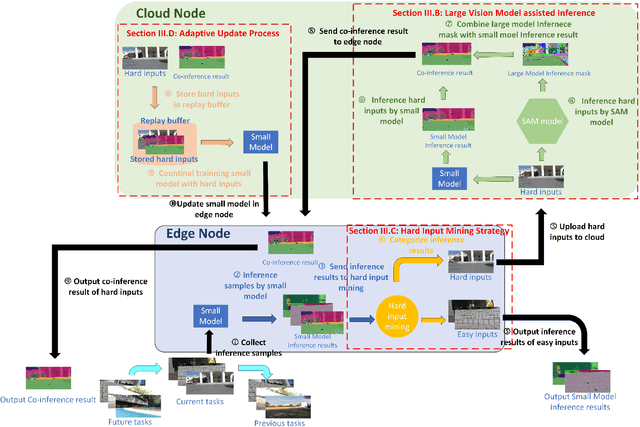
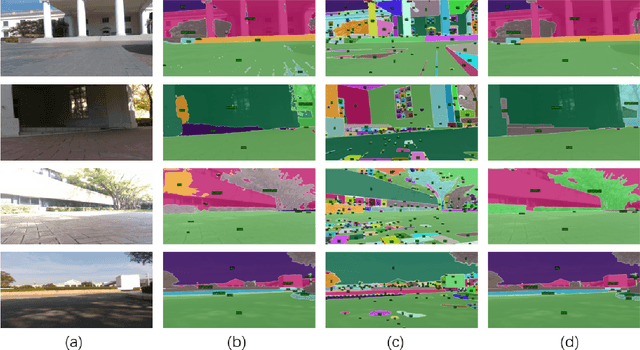

Abstract:Recent large vision models (e.g., SAM) enjoy great potential to facilitate intelligent perception with high accuracy. Yet, the resource constraints in the IoT environment tend to limit such large vision models to be locally deployed, incurring considerable inference latency thereby making it difficult to support real-time applications, such as autonomous driving and robotics. Edge-cloud collaboration with large-small model co-inference offers a promising approach to achieving high inference accuracy and low latency. However, existing edge-cloud collaboration methods are tightly coupled with the model architecture and cannot adapt to the dynamic data drifts in heterogeneous IoT environments. To address the issues, we propose LAECIPS, a new edge-cloud collaboration framework. In LAECIPS, both the large vision model on the cloud and the lightweight model on the edge are plug-and-play. We design an edge-cloud collaboration strategy based on hard input mining, optimized for both high accuracy and low latency. We propose to update the edge model and its collaboration strategy with the cloud under the supervision of the large vision model, so as to adapt to the dynamic IoT data streams. Theoretical analysis of LAECIPS proves its feasibility. Experiments conducted in a robotic semantic segmentation system using real-world datasets show that LAECIPS outperforms its state-of-the-art competitors in accuracy, latency, and communication overhead while having better adaptability to dynamic environments.
Combined Federated and Split Learning in Edge Computing for Ubiquitous Intelligence in Internet of Things: State of the Art and Future Directions
Jul 20, 2022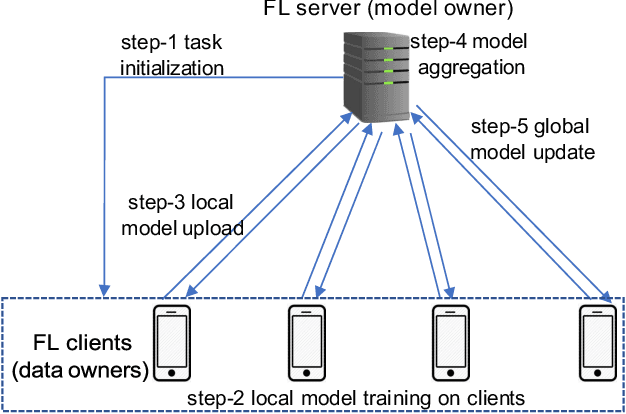
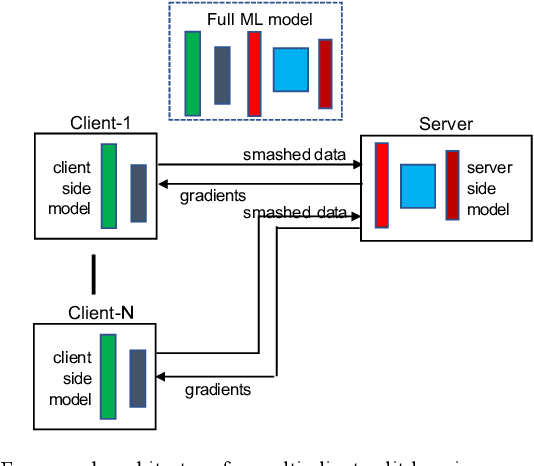
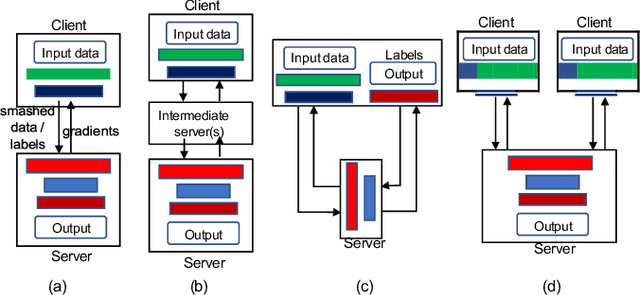
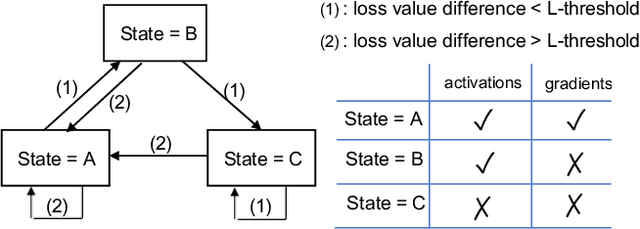
Abstract:Federated learning (FL) and split learning (SL) are two emerging collaborative learning methods that may greatly facilitate ubiquitous intelligence in Internet of Things (IoT). Federated learning enables machine learning (ML) models locally trained using private data to be aggregated into a global model. Split learning allows different portions of an ML model to be collaboratively trained on different workers in a learning framework. Federated learning and split learning, each has unique advantages and respective limitations, may complement each other toward ubiquitous intelligence in IoT. Therefore, combination of federated learning and split learning recently became an active research area attracting extensive interest. In this article, we review the latest developments in federated learning and split learning and present a survey on the state-of-the-art technologies for combining these two learning methods in an edge computing-based IoT environment. We also identify some open problems and discuss possible directions for future research in this area with a hope to further arouse the research community's interest in this emerging field.
 Add to Chrome
Add to Chrome Add to Firefox
Add to Firefox Add to Edge
Add to Edge